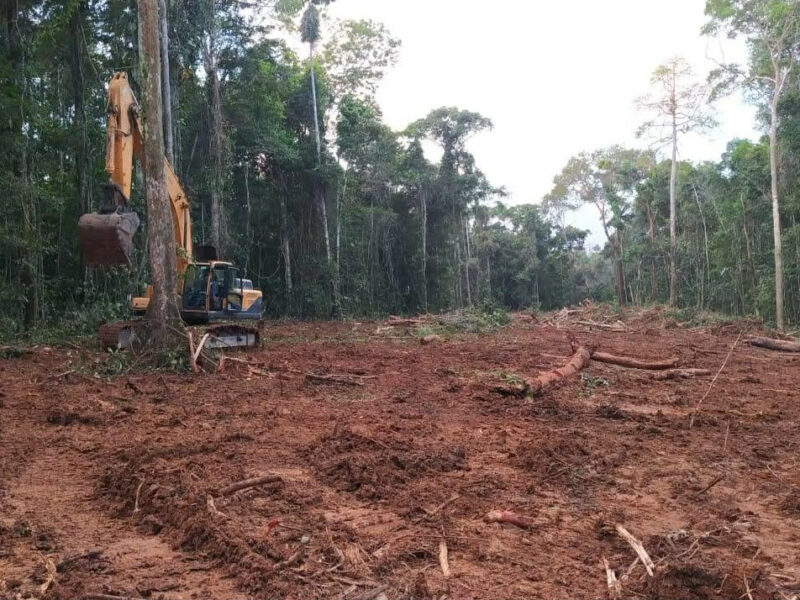A four-foot caiman lies belly-up in a still pool of water surrounded by a cluster of tall green cecropia trees. It has been dead for about five days and its white scaly body has become stiff and bloated. Nearby, behind a chainmail fence, a rusty network of pipes pumps cloudy residue into the Shiripuno river. The low rumble of a generator hums in the background.
The plant near Cononaco in the Huaorani reserve is one of a many oil separation and pumping facilities that are scattered across Yasuni national park in Ecuador’s Amazon rainforest. Further down the river, amid a thicket of tall yellow grass, a group of workers in blue boiler suits try to hose away a spill from a few months earlier. An oily rainbow sheen floats upon the nearby streams.
Since it controversially scrapped the Yasuni-ITT initiative last August – a plan that sought money from the international community to guarantee that oil beneath the park would remain unexploited – the Ecuadorian government has vowed that Yasuni will be left “99.9% intact” by oil extraction. But this pledge seems to ignore the fact that drilling platforms already litter the Unesco world heritage site.
Now it has emerged that, according to a 2009 government document, the Ecuadorian government was quietly in talks with a Chinese oil company and bank about a scheme to allow drilling in Yasuni even while the government was soliciting donations in return for protecting the forest.
“The way the ITT-initiative was sold to the world was deceptive,” explains Diocles Zambrano, a local activist. “It was sold as protecting the whole of Yasuni national park but … the Ishpingo-Tambococha-Tiputini (ITT) block accounts for less than one-sixth of the whole park and many other areas are already being exploited.”
The decision to drill in the ITT field adds to widespread industrial oil extraction across the Ecuadorian Amazon that over the last few decades has wreaked environmental havoc. In a bid to calm public opinion, the Ecuadorian government has undertaken a massive PR campaign emphasising that new drilling platforms will have minimal environmental impact.
But it does not like having this view challenged. In December, the government forcibly shut down the Quito office of indigenous rights group the Pachamama Foundation and journalists now wishing to visit Yasuni have to apply for permits that are often refused.
State-owned oil company PetroAmazonas has promised no new roads will be built to reach the new fields. The construction of roads is one of the chief causes of tropical deforestation, bringing uncontrollable secondary socio-envionmental impacts such as colonisation, overhunting, and illegal logging, which invariably lead to significant ecosystem degradation.
However, aerial footage shows 25-metre-wide roads being built deep into the surrounding forest. The government claims these arteries are in fact “ecological trails” but this explanation doesn’t pass muster with Alonso Jamarillo, the former director of the park. “They are just roads with a different name,” he says. “It is government misinformation.”
At the end of last year, Ecuador put 16 oil blocks in the Amazon jungle region to the south of Yasuni up for auction in an effort to drum up new joint-venture partners. “We’re on the cusp of a new oil boom in the Ecuadorian Amazon the like of which we have never seen before,” says Kevin Koenig, programme co-ordinator, at campaign group Amazon Watch.
This boom is underpinned by a massive multi-billion dollar debt-for-oil deal that the cash-strapped Ecuadorian government signed last year with China. “To meet higher production quotas Ecuador will have to increase oil extraction across the Amazon,” Koenig adds. “The whole of Yasuni is at risk.”
The ancestral land that belongs to the Sani Isla community, a Kichwa tribe living on the River Napo, snakes into Yasuni national park. The villagers complain that pressure from PetroAmazonas to move them off their land has been ramped up in recent months. “The tactics used have become much more aggressive,” says Patricio Jipa, a community leader. “Representatives from the oil company go house-to-house. They are trying to divide the community. They are very skilful. They spread rumours. They have tried to pay people off. They have put brother against brother. It’s become very difficult.”
These allegations were put to the Eduadorian government, who did not respond.
Just to the north of Yasuni, lies Tiputini Biodiversity Station, a scientific field research centre deep in the rainforest. “This job can be depressing,” says Diego Mosquera, senior resident manager, as he hacks away at the undergrowth to plant a camera trap.
“Everything has declined, especially big mammals, there used to be harpy eagles flying in the sky, sloths hanging from trees, but oil exploration is killing the rainforest. My goal is to keep accumulating scientific data so we know what we have in Yasuni, before we lose it.”













